December 1st, 2014 An unused stretch of wall space on the first floor of Spencer has become the new home to about fifty paintings formerly housed in the Kansas Collection and University Archives stacks. Following a visit to the collection storage area at the Spencer Museum of Art, Conservation Services staff installed a similar gridwall panel system.
.

Left: Wall space for hanging storage. Right: Installation of gridwall panels.
The panels are much like ones found in retail stores for displaying merchandise. They come in a variety of lengths and widths, which make them very adaptable to the existing environment in which they are placed. The walls on which the panels were mounted were a bit less cooperative, as evidenced by the number and wear on the bits used in drilling process.
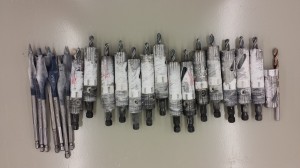
Large collection of drill bits used during the installation process.
Staff first attached painted wooden boards to the wall to reinforce the plaster surface. This also ensured that the hooks used for hanging the gridwall panels could be accurately fixed in place.
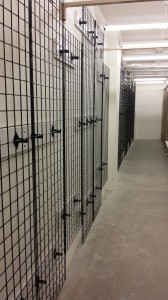
Installed gridwall panels.
Once the installation was complete, staff fastened d-ring hangers with short, pan-head wood screws to the frames or stretcher bars on the verso of the paintings. Although a few of the paintings were already equipped with hooks and wires, it was deemed more secure and stable to use the d-ring hangers for hanging on the panels. The use of a d-ring on each side of the frame/stretcher bar allows the painting to be hung from a pair of hooks. In this manner, the painting will not slide from side to side as it would when hung on a wire over a single hanger.

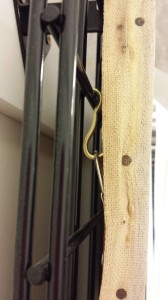
Left: Attaching d-rings to painting stretcher bar. Right: Painting with d-ring attached to hook, then to panel.
The paintings were then arranged salon-style, using the panel space as efficiently as possible. The paintings are now much easier to page for patrons. This is also a better storage environment for the items, as they are no longer standing on one side of their frame/stretcher bar or resting against one another.


Left: Paintings hung in place. Right: Tyvek drapery to protect paintings from dust and light.
As a final preservation strategy, the paintings have been draped in Tyvek. This material, best known for its application in house construction, is an excellent, light-weight covering to protect the paintings from dust and abrasion. In addition, we created a visual map of all the paintings to aid in paging them for patrons with the least disruption to the Tyvek drapery.
Roberta Woodrick
Assistant Conservator
Conservation Services
Tags: d-ring, gridwall panel, hanging storage, Kansas Collection, paintings, Roberta Woodrick, Tyvek, University Archives
Posted in Conservation, Kansas Collection, University Archives |
No Comments Yet »
November 10th, 2014 November is bringing good news for the storage conditions for many oversized, flat items in the Kansas Collection. After much planning and pondering, the existing wooden “cubby” storage unit has been dismantled to make way for flat file storage drawers often referred to as map cases.

Kansas Collection cubbies, full of collection material
Over time, paintings, other framed materials, and oversized architectural drawings had ended up in the cubbies for lack of a more suitable place to store these challengingly-shaped and often very large items.
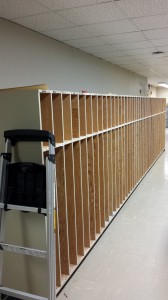
Empty Kansas Collection cubbies
Student employees and staff worked to clear collections from the wooden storage unit. Some of the materials will return to the newly installed map cases, while others have moved to an area specifically made for hanging paintings and framed objects. Conservation Services staff then took apart the cubbies using car jacks, pry bars, and a sledge hammer. The original structure of the cubbies relied heavily on a slot-in-tab method of construction which made for a smoother deconstruction than if the unit had been held together primarily with screws or nails.
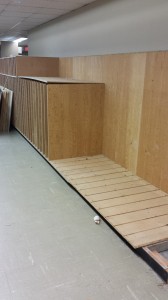
Partially dismantled cubbies
In a happy bit of up-cycling, a sculpture professor in the Art Department at KU collected the nearly 50-year old ply board to be used by students working in the Fine Arts and Design Schools. Facilities Operations staff leveled the area by installing tile over the bare concrete floor and then installed fifteen five-drawer sets of map cases.
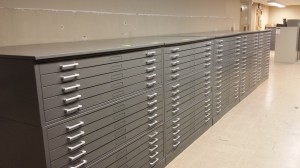
New map cases for flat storage
Over the coming months, oversized and flat material–housed in appropriately-sized folders–will be placed in the new cases. This will not only provide a better storage environment for the items, it will also make the materials easier to page for patron use.
Roberta Woodrick
Assistant Conservator
Conservation Services
Tags: conservation, cubbies, Kansas Collection, map case, Roberta Woodrick, slot storage
Posted in Conservation, Kansas Collection |
No Comments Yet »
April 4th, 2013 One of the most common questions we receive when new patrons enter the reading room is “what are those things on the desks?” Most users are able to identify the clear acrylic (plexiglas) stands as book cradles (used to support a book while it’s being read), but the cushion-y, fabric-based “things” lying next to them present more of a mystery.
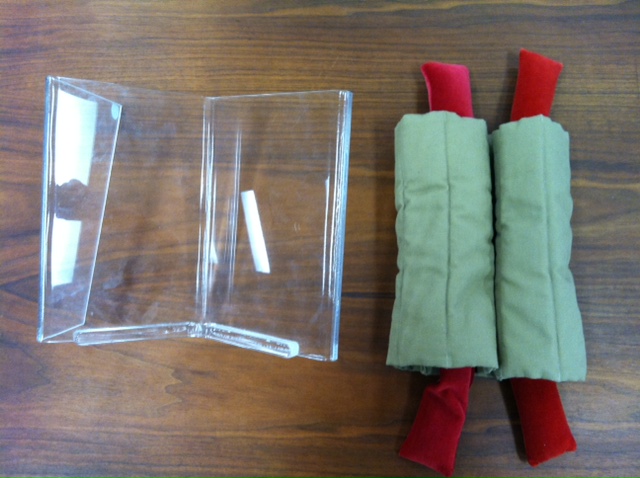
These are in fact another type of book support: one that consists of a roll-able, padded mat called a “book futon” and two long, pliable, cylindrical objects called “book snakes.” Since some of the volumes in our collections can be quite fragile, it is important to limit the stress on their bindings during use. By rolling the ends of a book futon (or futons) around book snakes, you can create an adjustable support to accommodate books of various sizes. The goal is to arrange the futon and snakes so that the volume lies open at a safe angle, with its “boards” supported. This minimizes the pressure on the book’s spine and hinges. Smaller book snakes (sometimes referred to affectionately as “book worms”) may be positioned on the book to keep it open to a given page.
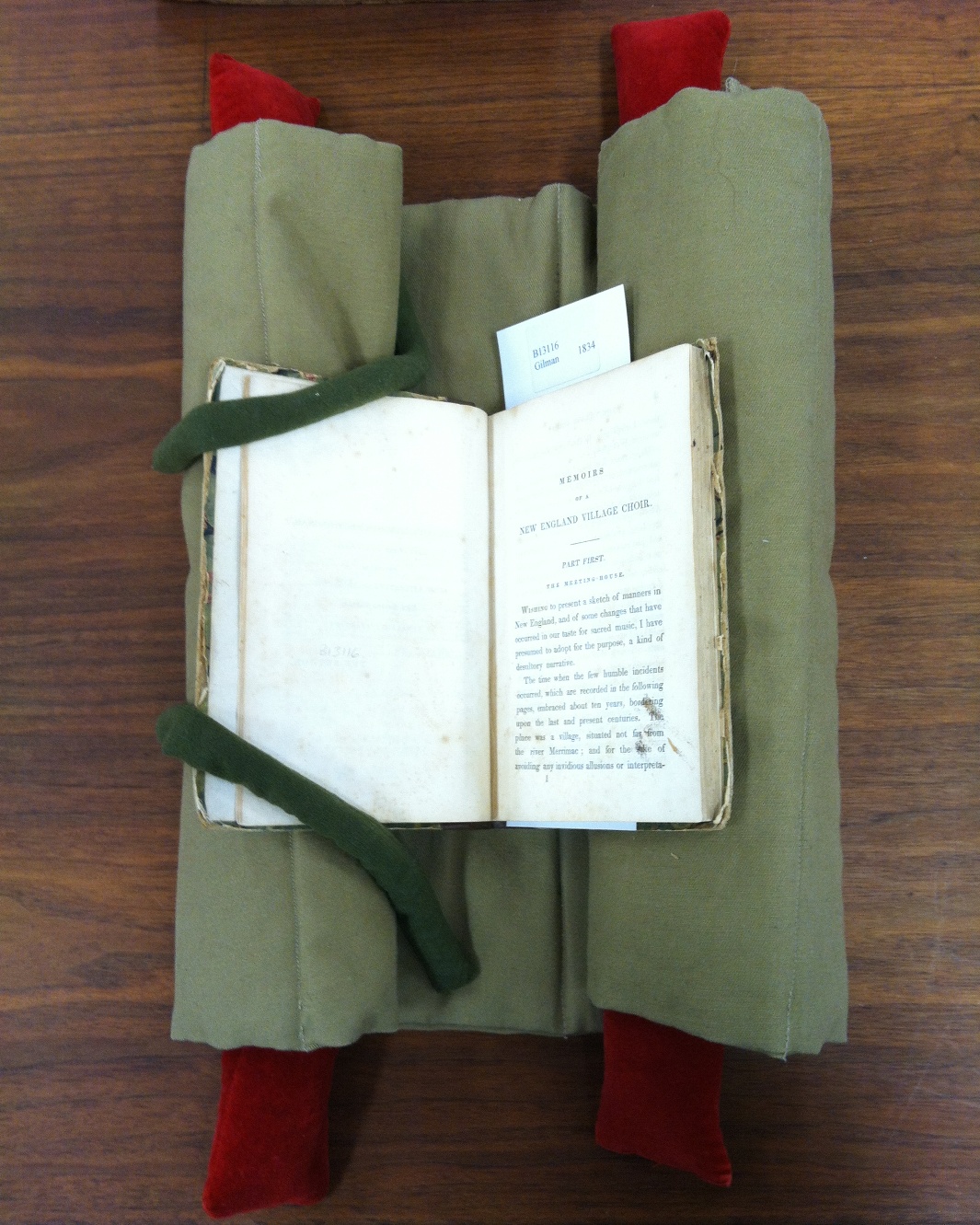
Book snakes are not only an essential tool when handling rare and fragile books; they can also prove quite handy for the average reader at home! (Think about all of the times that you’ve struggled to keep a cookbook open while following a recipe or have needed to prop a book open in order to take notes). Fortunately, making your own book snake is a relatively easy craft project. Roberta Woodrick of KU Libraries’ Conservation Services has made a wonderful video tutorial to walk you step by step through the process. The tutorial is based on the guidelines of Jennifer Hain Teper, Conservation Librarian at the University of Illinois at Urbana-Champaign. Enjoy!
How to Make a Book Snake, with Roberta Woodrick
Roberta Woodrick
Assistant Conservator, Conservation Services
and
Elspeth Healey
Special Collections Librarian
Tags: Book Cradles, Book Futons, Book Snakes, Book Supports, Book Worms, Conservation Services, crafts, Elspeth Healey, Jennifer Hain Teper, Roberta Woodrick
Posted in Conservation, Public Services |
No Comments Yet »














